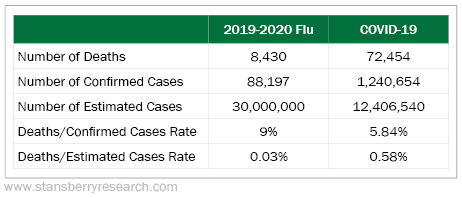I've pounded the table on this since February: We don't know the true numbers for the COVID-19 crisis.
And we may never know them.
First, we don't know the number of deaths truly caused by COVID-19. That's because in a grab for COVID-19-related funding, the Centers for Disease Control and Prevention ("CDC") is urging doctors to list COVID-19 as the cause of death no matter what.
Dr. Deborah Birx, the leader of the White House Coronavirus Task Force, put it bluntly: "Right now ... if someone dies with COVID-19 we are counting that as a COVID-19 death."
That means regardless of how many heart attacks you've had, any other infections you're fighting, or any of the other factors that we're seeing, the bottom line will say COVID-19. You'd be surprised to see how many folks don't die from COVID-19 alone – the coinfection rate is high, meaning folks tend to get other infections at the same time. How do we know what's caused by COVID-19 alone?
All that does is inflate the numbers to allow health organizations to ask for more money and stir up more needless panic in the public.
What's more, we don't have nearly enough tests to get a feel for the total number of people infected. In the U.S., we're only testing about 24 out of every 1,000 people... That's far below where we should be.
This means we don't have a clear scope of how widespread the virus is... or a good representation of how bad the mortality rate is. Right now, the fatality rate is 5.8%. But if we follow some reports suggesting that 10 folks have the virus for every 1 person who tests positive, that would drop the fatality rate to 0.58%.
Here's what really gets me, though: This is the same guesswork we use every year for the flu, too.
It turns out the CDC doesn't track flu cases for the entire country either. It uses data from the U.S. Influenza Surveillance System. That's a small network of providers that includes about 8.5% of the whole population. From there, they extrapolate the number of flu cases, hospitalizations, and deaths.
In other words, we ALSO don't have an accurate number of flu cases or deaths. We never do.
We looked at the data from the 2019 to 2020 season in the U.S. There are 8,430 deaths confirmed from the flu (though the estimated number is 24,000 to 62,000). And only 88,197 confirmed positive tests for the flu. But the CDC estimates about 30 million folks had the flu.
Let's break that down further:

Remember, the CDC estimates deaths and the number of cases. If we use the high and low end for estimated deaths for this past season, that makes the case fatality rate 0.08% to 0.2%. That's a ridiculous range for variance.
Think about the last time you had the flu or knew someone who got it. Did you go to the doctor or just wait it out at home? If you went to your doctor, did you get the flu test or was it a simple, "that's probably what you've got, here's what you need"?
The same is true for COVID-19. As I mentioned, few people have severe symptoms that make them seek out medical advice.
And with all the fear generated by the media, we now have people who are too scared to get help – or, in some cases, can't afford the medical bills so they choose to stay home. All this means is that we'll likely never know how bad the crisis really is... and whether or not these draconian shutdown measures were necessary.
There's much more to unpack about fatality rates, reporting errors, and the true problems with the COVID-19 madness. I covered it all in yesterday's issue of Retirement Millionaire. Check it out, here.
What We're Reading...
- Great article from Scientific American.
- Something different: Now this is an epic Costco run.
Here's to our health, wealth, and a great retirement,
Dr. David Eifrig and the Health & Wealth Bulletin Research Team
May 14, 2020
